Effects of Fuel Penetration on the RDE Performance with JISC Injector Configuration
Abstract
:1. Introduction
2. Experimental Description
3. Results
4. Conclusions
- (1)
- Image post-processing revealed that excessive jet penetration height negatively impacted both the initiation and sustainment of detonation. Notably, D4N15, which exhibited the highest jet penetration height, maintained a deflagration mode, while D4N23, with the second-highest penetration height, demonstrated a chaotic propagation mode.
- (2)
- STFT and FFT analyses were conducted on three injectors where detonation mode was sustained. Despite having narrower hole spacing and the capability for effective jet penetration height, D2N60 exhibited relatively unstable propagation characteristics compared to D4N30. This instability is likely attributed to the narrow spacing between the holes or its relatively high jet penetration height, which was the third highest among the injectors tested.
- (3)
- Each fuel injector was schematized based on design parameters, including hole spacing and jet penetration height. Despite D1N240 having low jet penetration height and a narrow gap between holes, its specific impulse was approximately 12% lower than that of D4N30. This result is likely attributable to insufficient jet penetration height. Therefore, it is essential to consider the optimization of design parameters to achieve an efficient injector performance.
Author Contributions
Funding
Data Availability Statement
Conflicts of Interest
References
- Kailasanath, K. Review of Propulsive applications of Detonation Waves. AIAA J. 2000, 38, 1698–1708. [Google Scholar] [CrossRef]
- Kailasanath, K. Recent Developments in the Research on Pulse Detonation Engines. AIAA J. 2003, 41, 145–159. [Google Scholar] [CrossRef]
- Wolański, P. Detonative Propulsion. Proc. Combust. Inst. 2013, 34, 125–158. [Google Scholar] [CrossRef]
- Li, J.M.; Teo, C.J.; Khoo, B.C.; Yao, S.; Wang, C. Detonation Control for Propulsion: Pulse Detonation and Rotating Detonation Engines; Shock Wave and High Pressure Phenomena; Springer: Berlin/Heidelberg, Germany, 2018. [Google Scholar]
- Lu, F.K.; Braun, E.M. Rotating Detonation Wave Propulsion: Experimental Challenges, Modeling, and Engine Concepts. J. Propuls. Power 2014, 30, 1125–1142. [Google Scholar] [CrossRef]
- Kim, J.M.; Niyasdeen, M.; Han, H.S.; Oh, S.; Choi, J.Y. Research Activities on PGC Propulsion based on RDE, Part I: Basic Studies. J. Korean Soc. Propuls. Eng. 2017, 21, 97–107. [Google Scholar] [CrossRef]
- Kim, J.M.; Niyasdeen, M.; Han, H.S.; Oh, S.; Choi, J.Y. Research Activities on PGC Propulsion Based on RDE, Part II: Application Studies. J. Korean Soc. Propuls. Eng. 2017, 21, 91–102. [Google Scholar] [CrossRef]
- Choi, J.Y.; Ma, F.H.; Yang, V. Some Numerical Issues on Simulation of Detonation Cell Structure. Combust. Explos. Shock Waves 2008, 44, 560–578. [Google Scholar] [CrossRef]
- Hishida, M.; Fujiwara, T.; Wolański, P. Fundamentals of Rotating Detonations. Shock Waves 2009, 19, 1–10. [Google Scholar] [CrossRef]
- Choi, J.Y.; Ma, F.; Yang, V. Numerical Simulation of Cellular Structure of Two-Dimensional Detonation Waves. In Proceedings of the 43rd AIAA Aerospace Science Meeting and Exhibit, Reno, Nevada, 10–13 January 2005; American Institute of Aeronautics and Astronautics, Inc.: Reston, VA, USA, 2005; p. 1174. [Google Scholar]
- Pavalavanni, P.K.; Kim, J.E.; Jo, M.S.; Choi, J.Y. Numerical Investigation of the Detonation Cell Bifurcation with Decomposition Technique. Aerospace 2023, 10, 318. [Google Scholar] [CrossRef]
- Cho, D.R.; Won, S.H.; Shin, J.R.; Choi, J.Y. Numerical Study of Three-Dimensional Detonation Wave Dynamics in a Circular Tube. Proc. Combust. Inst. 2013, 34, 1929–1937. [Google Scholar] [CrossRef]
- Rosato, D.A.; Thornton, M.; Sosa, J.; Bachman, C.; Goodwin, G.B.; Ahmed, K.A. Stabilized Detonation for Hypersonic Propulsion. Proc. Natl. Acad. Sci. USA 2021, 118, e2102244118. [Google Scholar] [CrossRef] [PubMed]
- Ishihara, K.; Nishimura, J.; Goto, K.; Nakagami, S.; Matsuoka, K.; Kasahara, J.; Matsuo, A.; Funaki, I.; Moriai, H.; Mukae, H.; et al. Study on a long-time Operation towards Rotating Detonation Rocket Engine Flight Demonstration. In Proceedings of the 55th AIAA Aerospace Sciences Meeting, Grapevine, TX, USA, 9–13 January 2017; p. 1062. [Google Scholar]
- Zonglin, J.; Zijian, Z.; Yunfeng, L.; Chun, W.; Changtong, L. Criteria for Hypersonic Air-Breathing Propulsion and its Experimental Verification. Chin. J. Aeronaut. 2021, 34, 94–104. [Google Scholar]
- Yamaguchi, M.; Matsuoka, K.; Kawasaki, A.; Kasahara, J.; Watanabe, H.; Matsuo, A. Supersonic Combustion Induced by Reflective Shuttling Shock Wave in Fan-Shaped Two-Dimensional Combustor. Proc. Combust. Inst. 2019, 37, 3741–3747. [Google Scholar] [CrossRef]
- Ma, F.; Choi, J.Y.; Yang, V. Thrust Chamber Dynamics and Propulsive Performance of Single-Tube Pulse Detonation Engines. J. Propuls. Power 2005, 21, 512–526. [Google Scholar] [CrossRef]
- Ma, F.; Choi, J.Y.; Yang, V. Thrust Chamber Dynamics and Propulsive Performance of Multitube Pulse Detonation Engines. J. Propuls. Power 2005, 21, 681–691. [Google Scholar] [CrossRef]
- Kim, J.M.; Han, H.S.; Choi, J.Y. The Experimental Study about the Effect of Operating Conditions on Multi-Tube Pulse Detonation Engine Performance. Int. J. Aeronaut. Space Sci. 2018, 19, 89–99. [Google Scholar] [CrossRef]
- Ma, F.; Choi, J.Y.; Yang, V. Propulsive Performance of Airbreathing Pulse Detonation Engines. J. Propuls. Power 2006, 22, 1188–1203. [Google Scholar] [CrossRef]
- Ma, F.; Choi, J.Y.; Yang, V. Internal Flow Dynamics in a Valveless Airbreathing Pulse Detonation Engine. J. Propuls. Power 2008, 24, 479–490. [Google Scholar] [CrossRef]
- Yi, T.H.; Lou, J.; Turangan, C.; Choi, J.Y.; Wolański, P. Propulsive Performance of a Continuously Rotating Detonation Engine. J. Propuls. Power 2011, 27, 171–181. [Google Scholar] [CrossRef]
- Jones, S.M.; Paxcon, D.E. Potential Benefits to Commercial Propulsion Systems from Pressure Gain Combustion. In Proceedings of the 49th AIAA/ASME/SAE/ASEE Joint Propulsion Conference, San Jose, CA, USA, 14–17 July 2013; American Institute of Aeronautics and Astronautics, Inc.: Reston, VA, USA, 2013; p. 3623. [Google Scholar]
- Frolov, S.M.; Dubrovskii, A.V.; Ivanov, V.S. Three-Dimensional Numerical Simulation of Operation Process in Rotating Detonation Engine. Prog. Propuls. Phys. 2013, 4, 467–488. [Google Scholar]
- Sousa, J.; Paniagua, G.; Morata, E.C. Thermodynamic Analysis of a Gas Turbine Engine with a Rotating Detonation Combustor. Appl. Energy 2017, 195, 247–256. [Google Scholar] [CrossRef]
- Strakey, P.; Ferguson, D.; Sisler, A.; Nix, A. Computationally Quantifying Loss Mechanisms in a Rotating Detonation Engine. In Proceedings of the 54th AIAA Aerospace Sciences Meeting, San Diego, CA, USA, 4–8 January 2016. [Google Scholar]
- Wolański, P. Application of the Continuous Rotating Detonation to gas Turbine. Appl. Mech. Mater. 2015, 782, 3–12. [Google Scholar] [CrossRef]
- Frolov, S.M.; Aksenov, V.S.; Ivanov, V.S. Experimental Proof of Zel’dovich Cycle Efficiency Gain over Cycle with Constant Pressure Combustion for Hydrogen—Oxygen Fuel Mixture. Int. J. Hydrogen Energy 2015, 40, 6970–6975. [Google Scholar] [CrossRef]
- Teasley, T.W.; Fedotowsky, T.M.; Gradl, P.R.; Austin, B.L.; Heister, S.D. Current State of NASA Continuously Rotating Detonation Cycle Engine Development. In Proceedings of the AIAA SciTech 2023 Forum, National Harbor, MD, USA, 23–27 January 2023. [Google Scholar]
- Goto, K.; Matsuoka, K.; Matsuyama, K.; Kawasaki, A.; Watanabe, H.; Itouyama, N.; Ishihara, K.; Buyakofu, V.; Noda, T.; Kasahara, J.; et al. Space Flight Demonstration of Rotating Detonation Engine Using Sounding Rocket S-520-31. J. Spacecr. Rocket. 2023, 60, 273–285. [Google Scholar] [CrossRef]
- Kawalec, M.; Wolański, P.; Perkowski, W.; Bilar, A. Development of a Liquid-Propellant Rocket Powered by a Rotating Detonation Engine. J. Propuls. Power 2023, 39, 554–561. [Google Scholar] [CrossRef]
- Ishihara, K.; Yoneyama, K.; Watanabe, H.; Itouyama, N.; Kawasaki, A.; Matsuoka, K.; Kasahara, J.; Matsuo, A.; Funaki, I.; Higashino, K. Thrust Performance of Converging Rotating Detonation Engine Compared with Steady Rocket Engine. J. Propuls. Power 2023, 39, 297–307. [Google Scholar] [CrossRef]
- Bach, E.; Paschereit, C.O.; Stathopoulos, P.; Bohon, M. Advancement of Empirical Model for Stagnation Pressure Gain in RDCs. In Proceedings of the AIAA SciTech 2022 Forum, San Diego, CA, USA, 3–7 January 2022. [Google Scholar]
- Liu, X.Y.; Luan, M.Y.; Chen, Y.L.; Wang, J.P. Flow-Field Analysis and Pressure Gain Estimation of a Rotating Detonation Engine with Banded Distribution of Reactants. Int. J. Hydrogen Energy 2020, 45, 19976–19988. [Google Scholar] [CrossRef]
- Goto, K.; Yokoo, R.; Kawasaki, A.; Matsuoka, A.; Kasahara, J.; Matsuo, A.; Funaki, I.; Kawashima, H. Investigation into the Effective Injector Area of a Rotating Detonation Engine with Impact of Backflow. Shock Waves 2021, 31, 753–762. [Google Scholar] [CrossRef]
- Plaehn, E.W.; Walters, I.V.; Gejji, R.M.; Slabaugh, C.D. Bifurcation in Rotating Detonation Engine Operation with Continuously Variable Fuel Injection Location. J. Propuls. Power 2023, 39, 202–216. [Google Scholar] [CrossRef]
- Koo, I.H.; Lee, K.H.; Kim, M.S.; Han, H.S.; Kim, H.; Choi, J.Y. Effects of Injector Configuration on the Detonation Characteristics and Propulsion Performance of Rotating Detonation Engine (RDE). Aerospace 2023, 10, 949. [Google Scholar] [CrossRef]
- Matsuoka, K.; Tanaka, M.; Noda, T.; Kawasaki, A.; Kasahara, J. Experimental Investigation on a Rotating Detonation Cycle with Burned Gas Backflow. Combust. Flame 2021, 225, 13–19. [Google Scholar] [CrossRef]
- Bennewitz, J.W.; Bigler, B.R.; Pilgram, J.J.; Hargus, W.A., Jr. Modal Transitions in Rotating Detonation Rocket Engines. Int. J. Energetic Mater. Chem. Propuls. 2019, 18, 91–109. [Google Scholar] [CrossRef]
- Rankin, B.A.; Richardson, D.R.; Caswell, A.W.; Naples, A.G.; Hoke, J.L.; Schauer, F.R. Chemiluminescence Imaging of an Optically Accessible Non-Premixed Rotating Detonation Engine. Combust. Flame 2017, 176, 12–22. [Google Scholar] [CrossRef]
- Duvall, J.; Chacon, F.; Harvey, C.; Gamba, M. Study of the Effects of Various Injection Geometries on the Operation of a Rotating Detonation Engine. In Proceedings of the 2018 AIAA Aerospace Sciences Meeting, Kissimmee, FL, USA, 8–12 January 2018. [Google Scholar]
- Bohon, M.D.; Bluemner, R.; Paschereit, C.O.; Gutmark, E.J. High-Speed Imaging of Wave Modes in an RDC. Exp. Therm. Fluid Sci. 2019, 102, 28–37. [Google Scholar] [CrossRef]
- Zhao, M.; Zhang, H. Origin and Chaotic Propagation of Multiple Rotating Detonation Waves in Hydrogen/Air Mixtures. Fuel 2020, 275, 117986. [Google Scholar] [CrossRef]
- Bigler, B.R.; Burr, J.R.; Bennewitz, J.W.; Danczyk, S.; Hargus, W.A. Performance Effects of Mode Transitions in a Rotating Detonation Rocket Engine. In Proceedings of the AIAA Propulsion and Energy 2020 Forum, Online, 24–28 August 2020. [Google Scholar]
- Lee, J.H.; Ryu, J.H.; Lee, E.S.; Han, H.S.; Choi, J.Y. Experimental Proof of Concept of a Noncircular Rotating Detonation Engine (RDE) for Propulsion Applications. Aerospace 2022, 10, 27. [Google Scholar] [CrossRef]
- Han, H.S.; Lee, E.S.; Choi, J.Y. Experimental Investigation of Detonation Propagation Modes and Thrust Performance in a Small Rotating Detonation Engines Using C2H4/O2 Propellant. Energies 2021, 14, 1381. [Google Scholar] [CrossRef]
- Lin, W.; Zhou, J.; Liu, S.; Lin, Z.; Zhuang, F. Experimental Study on Propagation Mode of H2/Air Continuously Rotating Detonation Wave. Int. J. Hydrogen Energy 2015, 40, 1980–1993. [Google Scholar] [CrossRef]
- Jia, B.; Zhang, Y.; Meng, H.; Meng, F.; Pan, H.; Hong, Y. Experimental Study on the Propagation Characteristics of Rotating Detonation Wave with Liquid Hydrocarbon/High-Enthalpy Air Mixture. Aerospace 2023, 10, 682. [Google Scholar] [CrossRef]
- Ding, C.; Wu, Y.; Xu, G.; Xia, Y.; Li, Q.; Weng, C. Effects of the Oxygen Mass Fraction on the Wave Propagation Modes in a Kerosene-Fueled Rotating Detonation Combustor. Acta Astronaut. 2022, 195, 204–214. [Google Scholar] [CrossRef]
- Bluemner, R.; Bohon, M.D.; Paschereit, C.O.; Gutmark, E.J. Counter-Rotating Wave Mode Transition Dynamics in an RDC. Int. J. Hydrogen Energy 2019, 44, 7628–7641. [Google Scholar] [CrossRef]
- Lee, S.H.; Cho, D.R.; Choi, J.Y. Effect of Curvature on the Detonation Wave Propagation Characteristics in Annular Channel. In Proceedings of the 46th AIAA Aerospace Sciences Meeting and Exhibit, Reno, Nevada, 7–10 January 2008; American Institute of Aeronautics and Astronautics, Inc.: Reston, VA, USA, 2008; p. 988. [Google Scholar]
- Kim, T.Y.; Choi, J.Y. Numerical Study of Detonation Wave Propagation in 2-D Channels of Arbitrary Radius of Curvature. AIAA J. 2014, 20, 14–3903. [Google Scholar]
- Niyasdeen, M.; Oh, S.; Kim, K.S.; Choi, J.Y. Quasi-steady State Simulation of Rotating Detonation Engine. Int. J. Aeronaut. Space Sci. 2015, 16, 548–559. [Google Scholar] [CrossRef]
- Nejaamtheen, M.N.; Kim, T.Y.; Pavalavanni, P.K.; Ryu, J.; Choi, J.Y. Effects of the Dimensionless Radius of an Annulus on the Detonation Propagation Characteristics in Circular and Non-Circular Rotating Detonation Engines. Shock Waves 2021, 31, 703–715. [Google Scholar] [CrossRef]
- Kim, K.M.; Baek, S.W.; Kim, Y.G. Effects of Aspect Ratio of a Fuel Injection Nozzle into a Supersonic Air Stream on Combustion Characteristics. J. Korean Soc. Propuls. Eng. 2004, 8, 44–53. [Google Scholar]
- Gruber, M.R.; Nejad, A.S.; Chen, T.H.; Dutton, J.C. Mixing and Penetration Studies of Sonic Jets in a Mach 2 Freestream. J. Propuls. Power 1995, 11, 315–323. [Google Scholar] [CrossRef]
- Brunner, E. Fluid Mixtures at High Pressures II: Phase Separation and Critical Phenomena of (ethane + an n-alkanol) and of (ethane + methanol) and (propane + methanol). J. Chem. Thermodyn. 1985, 17, 871. [Google Scholar] [CrossRef]
- Jahangiri, M. A Thermodynamics Property Formulation for Ethylene from the Freezing Line to 450 K at Pressure to 260 MPa. Ph.D. Thesis, Unviersity of Idaho, Moscow, ID, USA, 1984. [Google Scholar]
- Tsonopoulous, C.; Ambrose, D. Vapor-Liquid Critical Properties of Elements and Compounds. 6. Unsaturated Aliphatic Hydrocarbons. J. Chem. Eng. 1996, 41, 645–656. [Google Scholar]

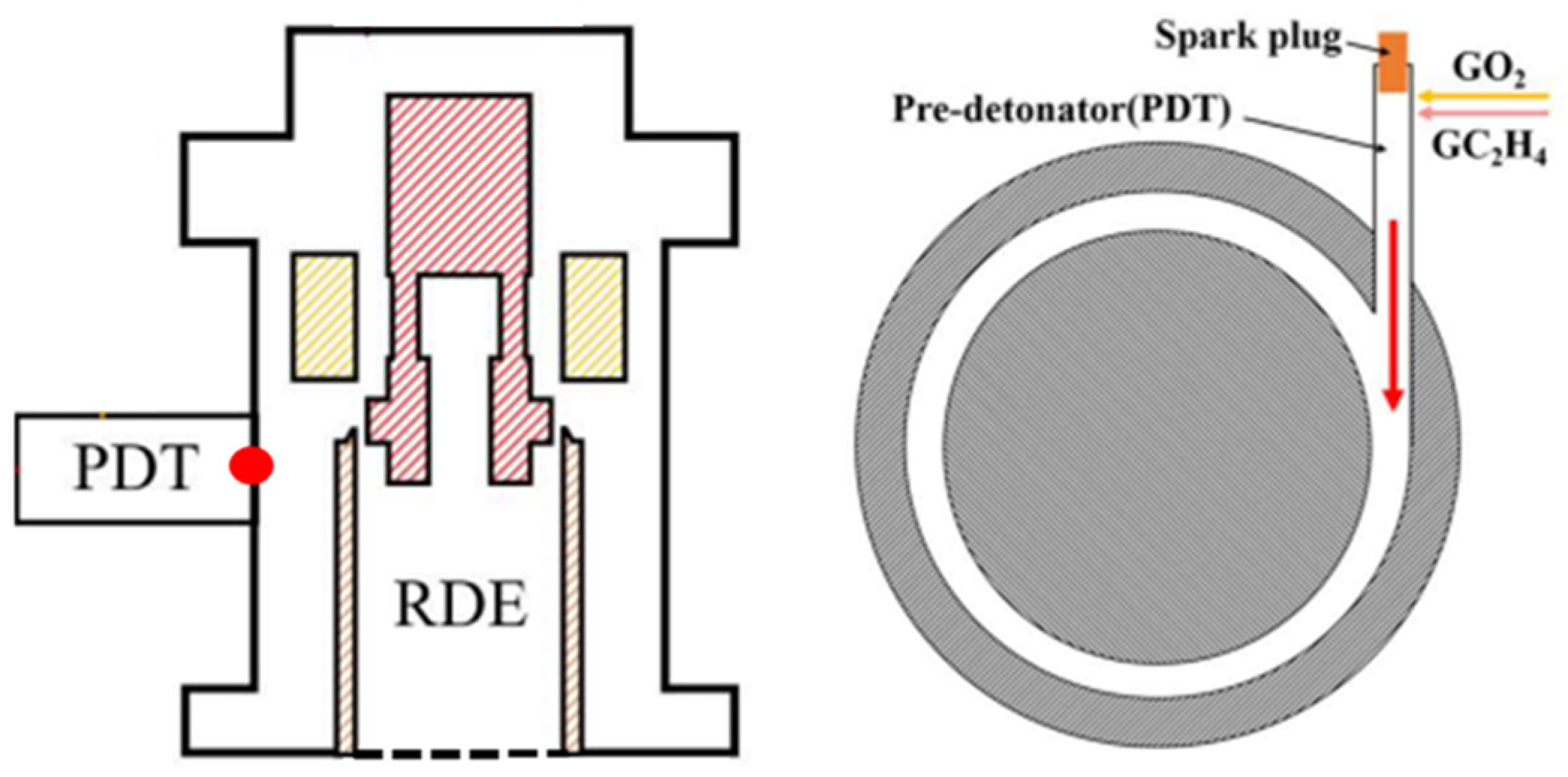
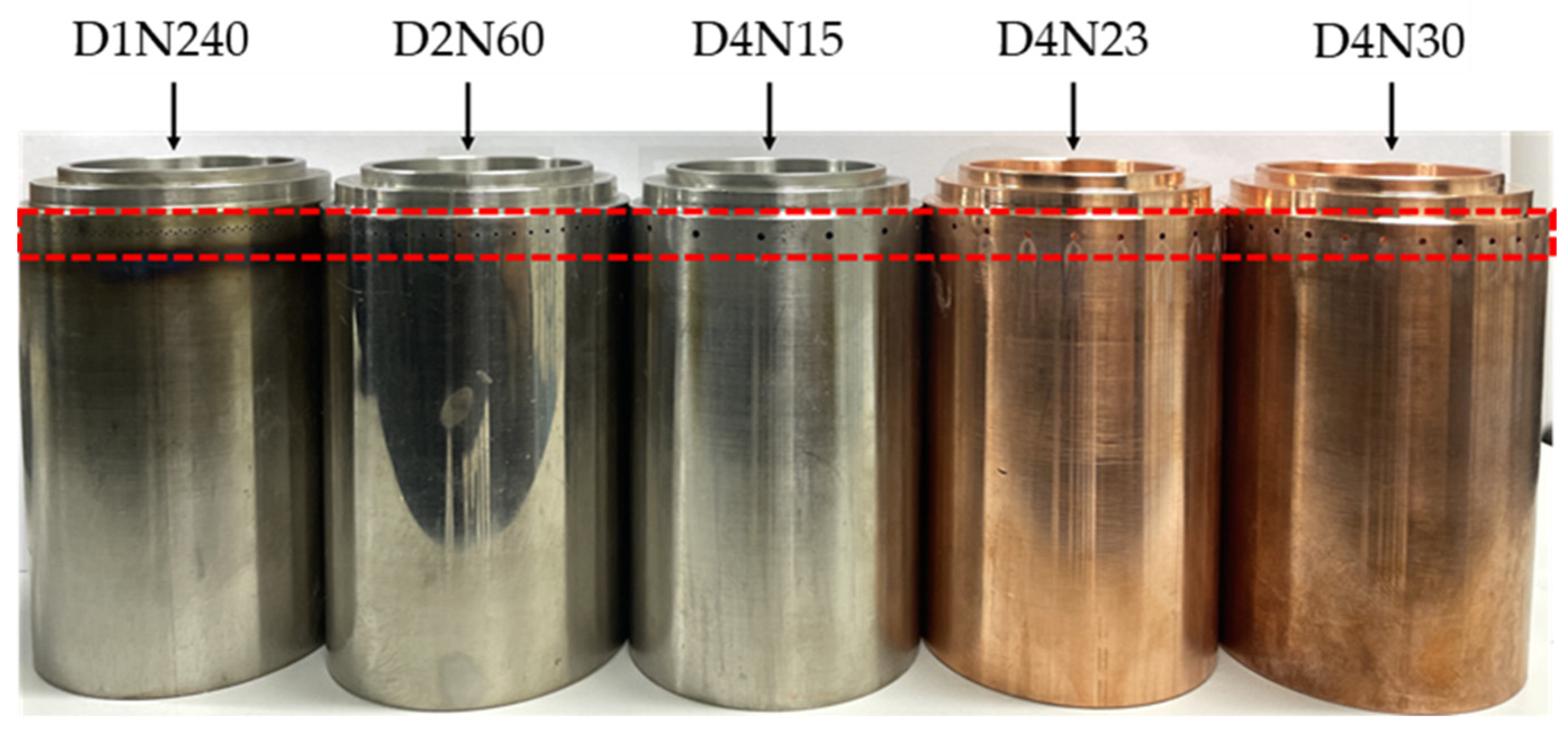
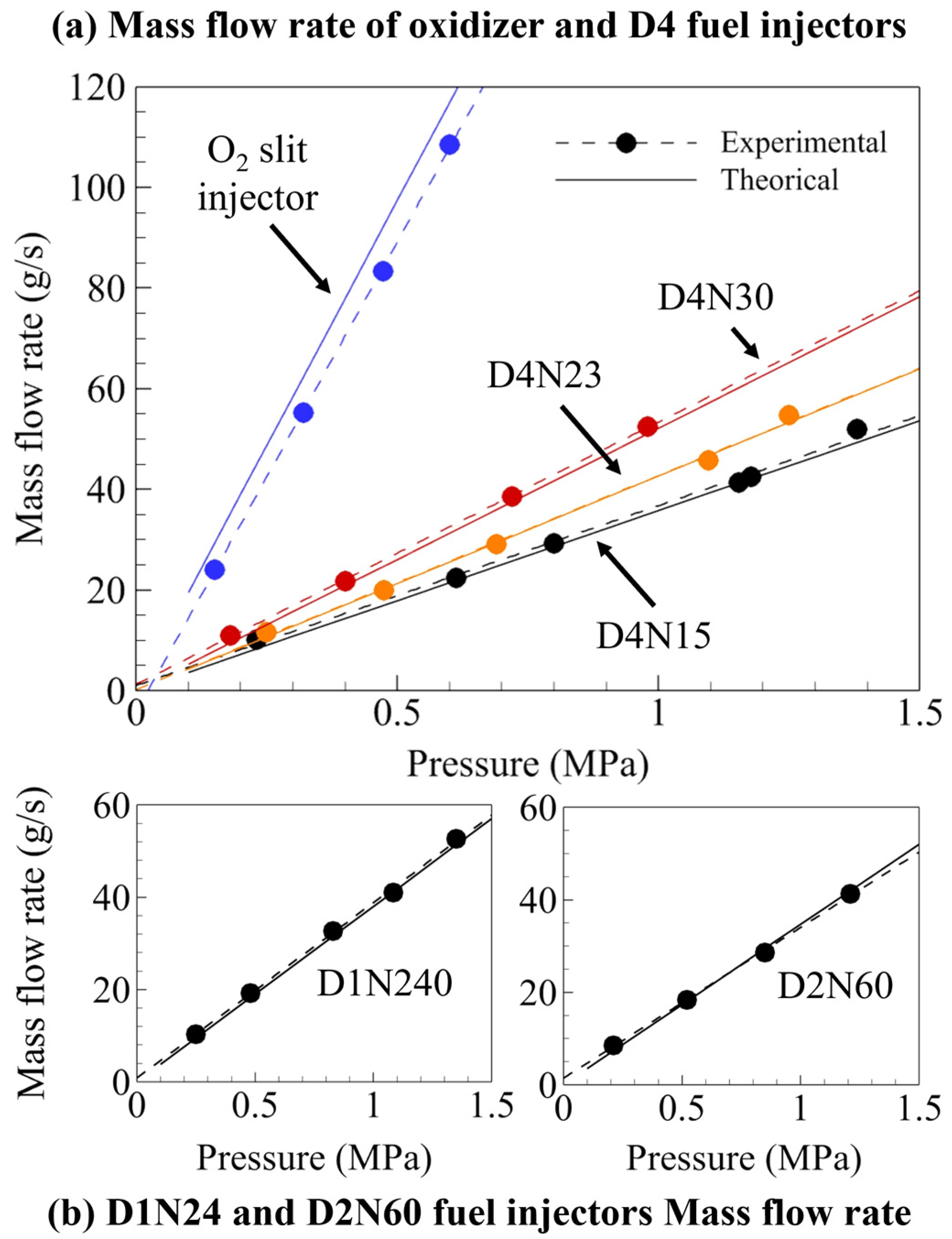
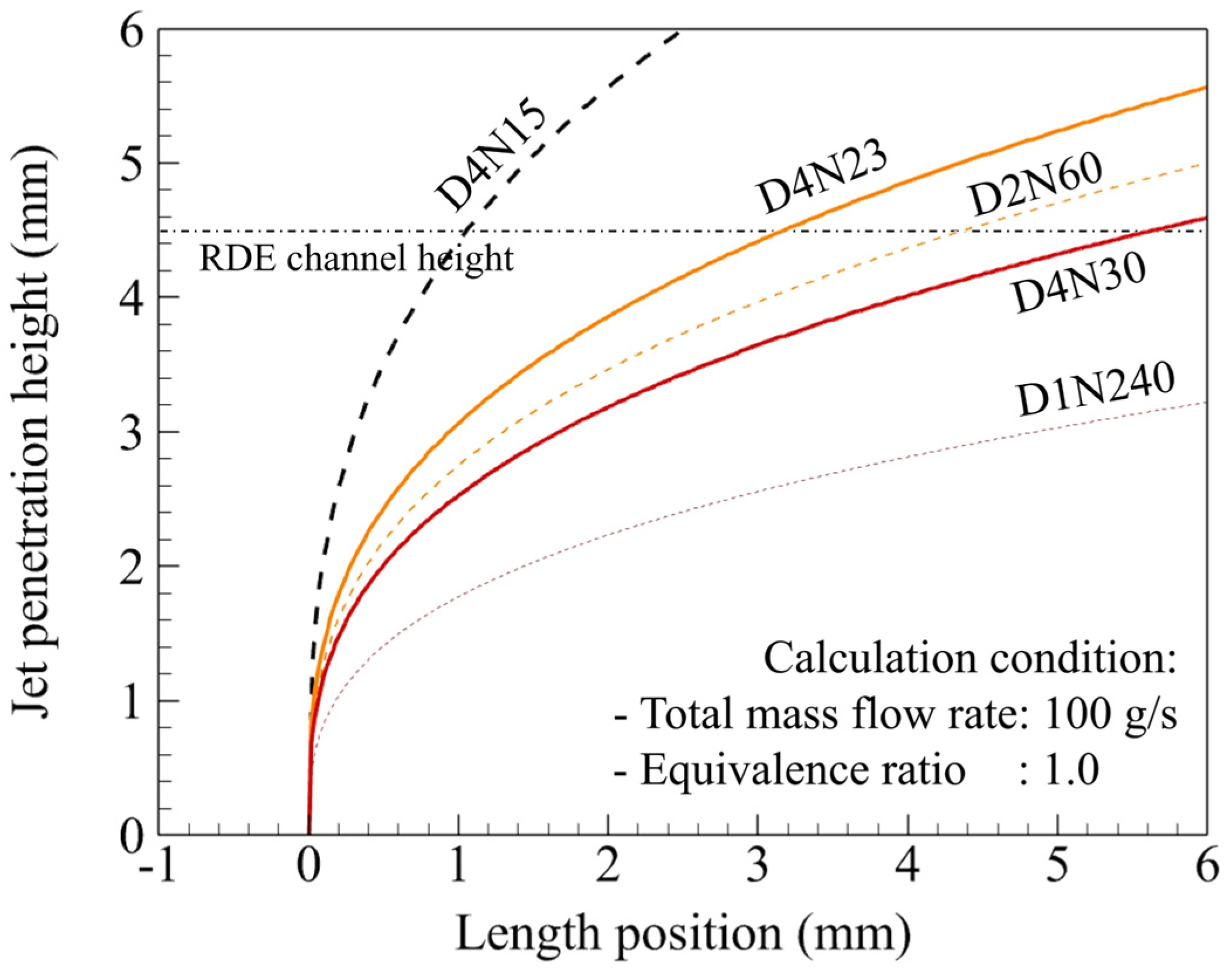
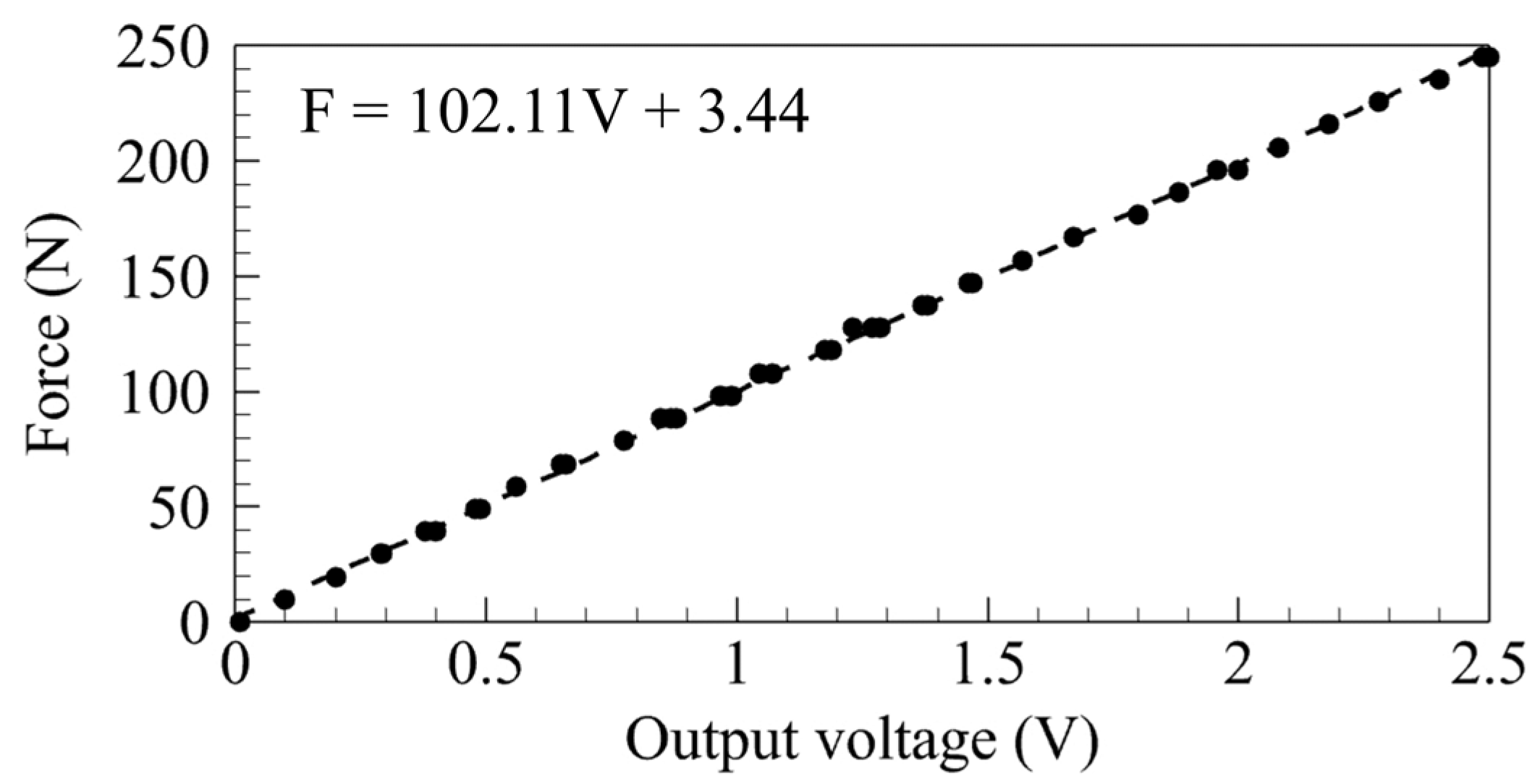
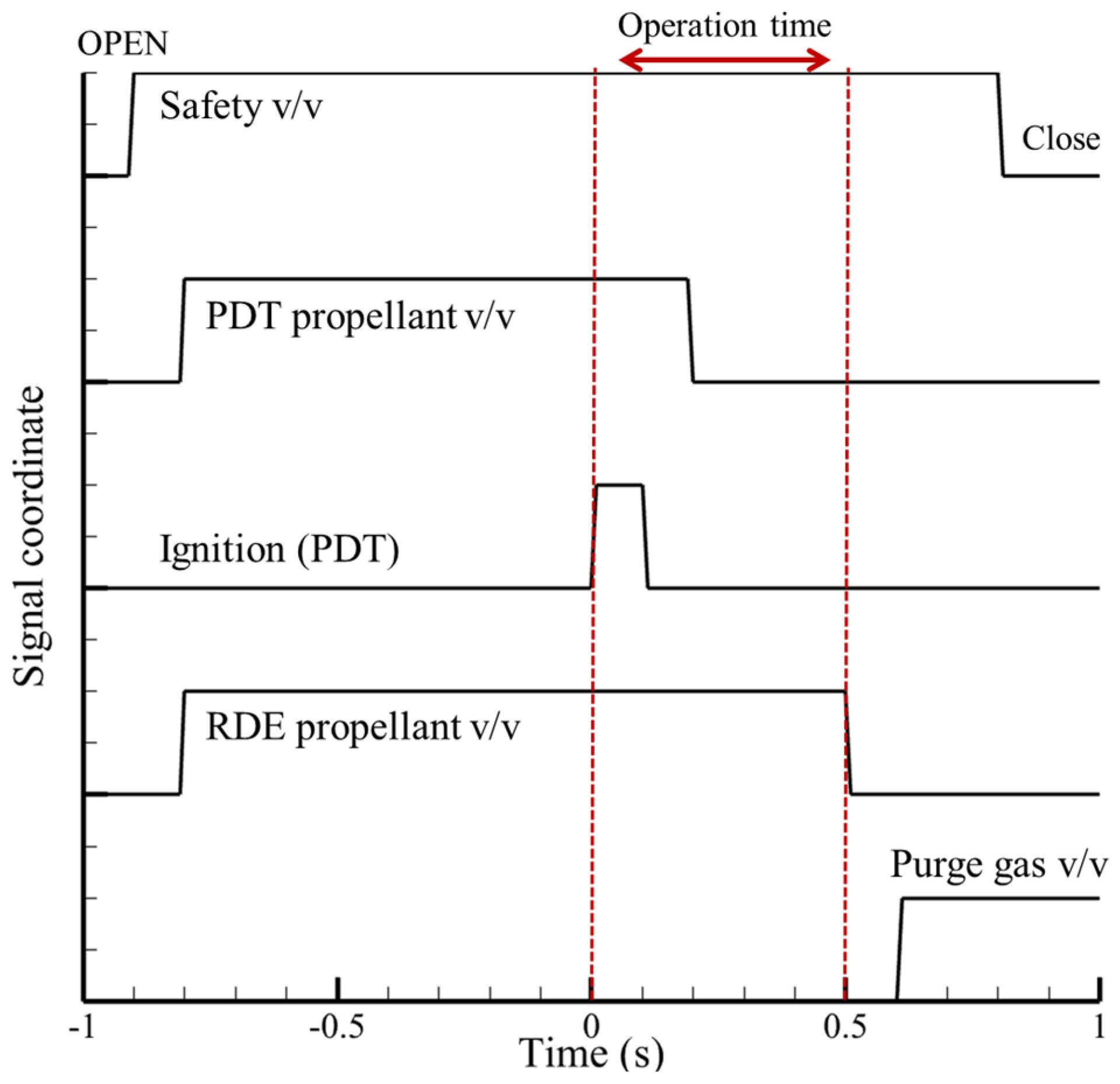

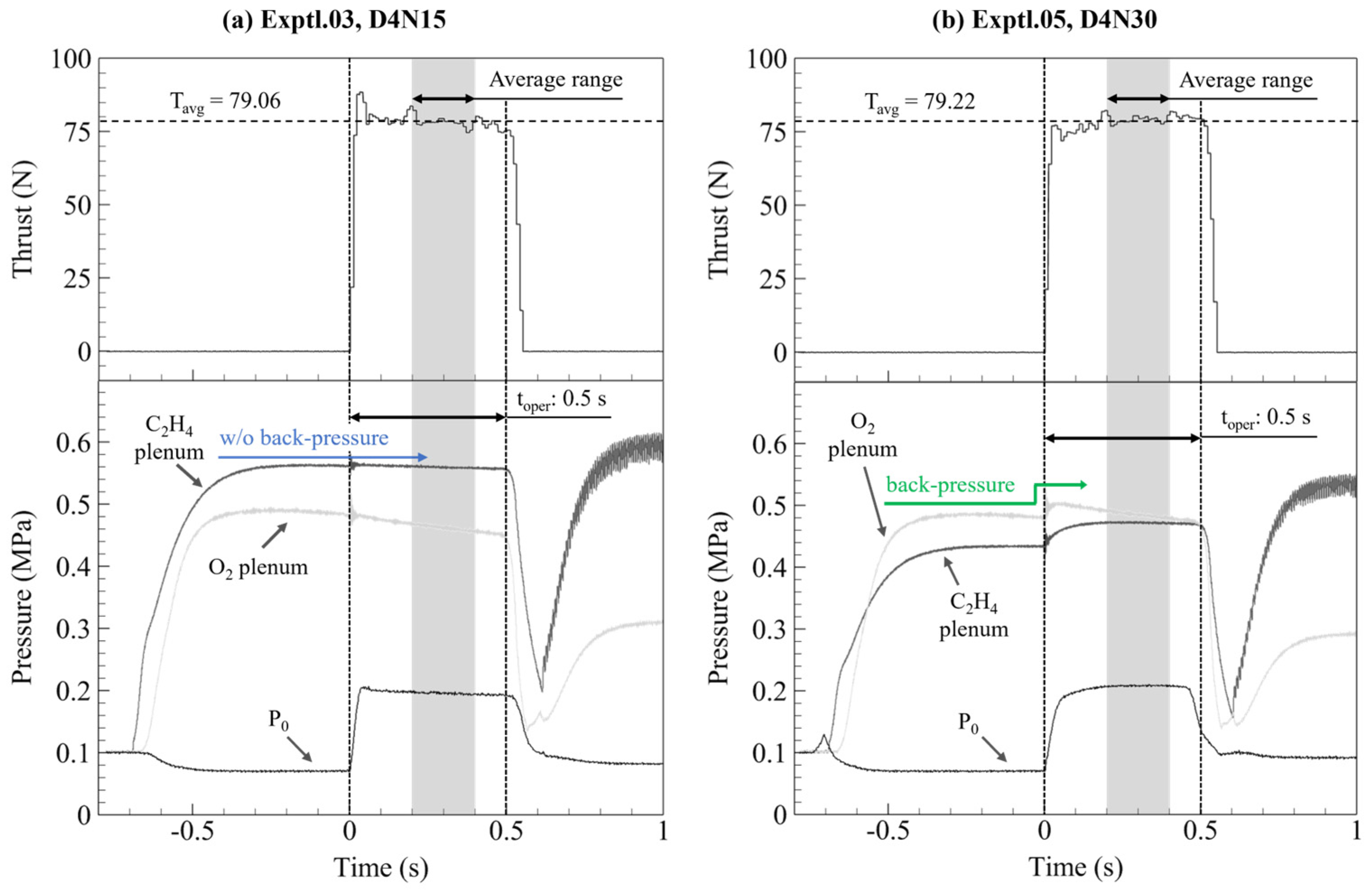


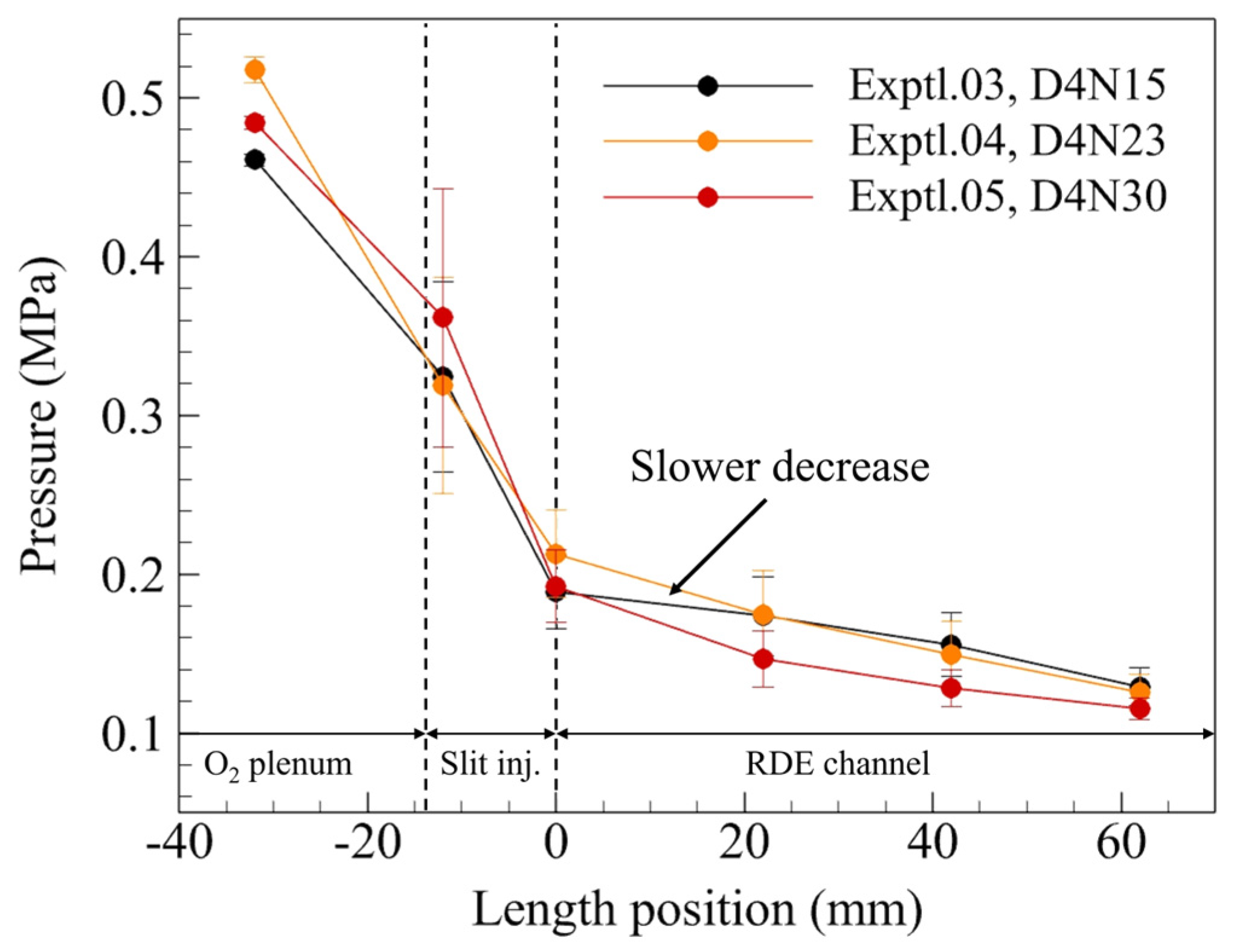

| Injector | Nhole | Ideal Design | Actual Design | Materials | ||
|---|---|---|---|---|---|---|
| Dhole (mm) | Af,inj (mm2) | Dhole (mm) | Af,inj (mm2) | |||
| D1N240 | 240 | 0.25 | 11.78 | 0.30 | 17.22 | SUS316 |
| D2N60 | 60 | 0.50 | 11.78 | 0.58 | 15.72 | SUS316 |
| D4N15 | 15 | 1.0 | 11.78 | 1.17 | 16.20 | SUS316 |
| D4N23 | 23 | 1.0 | 18.06 | 1.03 | 19.31 | C1100 |
| D4N30 | 30 | 1.0 | 23.55 | 1.00 | 23.63 | C1100 |
| (a) | ||
| Pc (bar) | Reference | Comment |
| 50.55 1 | Brunner [57] | Uncertainty assigned by TRC = 0.0504 bar |
| 50.403 1 | Jahangiri [58] | Uncertainty assigned by TRC = 0.002 bar |
| 50.41 ± 0.04 1 | Tsonopoulos and Ambrose [59] | - |
| (b) | ||
| T (K) | Reference | Comment |
| 282.33 1 | Brunner [57] | Uncertainty assigned by TRC = 0.0504 K |
| 282.34 1 | Jahangiri [58] | Uncertainty assigned by TRC = 0.002 K |
| 282.3 ± 0.02 1 | Tsonopoulos and Ambrose [59] | - |
| Experiment | Injector | (g/s) | Combustion Mode | fDW (kHz) | Isp (s) | |
| Exptl.01 | D1N240 | 103 | 0.98 | Detonation | 19.73 | 65.98 |
| Exptl.02 | D2N60 | 107 | 1.09 | Detonation | 22.50 | 67.97 |
| Exptl.03 | D4N15 | 109 | 1.14 | Deflagration | - | 73.94 |
| Exptl.04 | D4N23 | 105 | 1.11 | Chaotic Propagation | 22.50 | 78.25 |
| Exptl.05 | D4N30 | 107 | 1.01 | Detonation | 21.21 | 75.47 |
Disclaimer/Publisher’s Note: The statements, opinions and data contained in all publications are solely those of the individual author(s) and contributor(s) and not of MDPI and/or the editor(s). MDPI and/or the editor(s) disclaim responsibility for any injury to people or property resulting from any ideas, methods, instructions or products referred to in the content. |
© 2024 by the authors. Licensee MDPI, Basel, Switzerland. This article is an open access article distributed under the terms and conditions of the Creative Commons Attribution (CC BY) license (https://creativecommons.org/licenses/by/4.0/).
Share and Cite
Mo, G.-U.; Koo, I.-H.; Lee, K.-H.; Choi, S.-W.; Choi, J.-Y. Effects of Fuel Penetration on the RDE Performance with JISC Injector Configuration. Aerospace 2024, 11, 752. https://doi.org/10.3390/aerospace11090752
Mo G-U, Koo I-H, Lee K-H, Choi S-W, Choi J-Y. Effects of Fuel Penetration on the RDE Performance with JISC Injector Configuration. Aerospace. 2024; 11(9):752. https://doi.org/10.3390/aerospace11090752
Chicago/Turabian StyleMo, Gyeong-Ui, In-Hoi Koo, Keon-Hyeong Lee, Su-Wan Choi, and Jeong-Yeol Choi. 2024. "Effects of Fuel Penetration on the RDE Performance with JISC Injector Configuration" Aerospace 11, no. 9: 752. https://doi.org/10.3390/aerospace11090752







